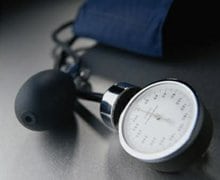What do you really know about hypertension?
It’s a common belief that people with high blood pressure experience symptoms of the disease, such as nervousness, sweating, difficulty sleeping or facial flushing. The truth? High blood pressure is largely symptomless. Everybody should know his or her blood pressure numbers; it’s why the nurse whips out the blood pressure cuff every time you go to the doctor’s office or the emergency room. Ignore these numbers because you think symptoms will alert you to a problem (or try to diagnose yourself), and you could be playing hypertension Russian roulette. This is especially true for black folks; we have the highest hypertension rates in the world.
Myth 1: Headaches
You’ve had a low-grade headache for a week. Your mother says, “Get your blood pressure checked. You know headaches are a symptom it’s elevated.” This is false. Evidence indicates that high blood pressure does not cause headaches—unless you are in hypertensive crisis (dangerously high numbers: systolic—top number—higher than 180 or diastolic—bottom number—higher than 110).
The evolution of this myth: In the early 1900s, the medical community assumed headaches were more common among people with high blood pressure. But research disagrees. In fact, in one study, published in the journal Neurology, people with high blood pressure had significantly fewer headaches than the general population. In the study, people with higher systolic blood pressure were up to 40 percent less likely to have headaches compared to those with healthier blood pressure readings. The researchers also looked at pulse pressure (the change in blood pressure when the heart contracts) and found those with higher pulse pressure had up to 50 percent fewer headaches. The science suggests that the higher the pulse pressure, the stiffer the blood vessels. The stiffer the blood vessels, the less likely the nerve endings are working properly. If the nerve endings aren’t functioning correctly, the less likely a person will feel pain. In other words, headaches, or the lack of them, aren’t reliable indicators of your blood pressure.
Myth 2: Nosebleeds
Nosebleeds can be caused by a variety of factors. The most common one is dry air. The lining of the nose contains many tiny blood vessels that can bleed easily. In a hot climate or with heated indoor air, the nasal membranes can dry out and make the nose more susceptible to bleeding. Other causes include vigorous nose blowing; medical conditions like allergies, colds, sinusitis or a deviated septum; and side effects from some anticoagulant drugs like warfarin or aspirin.
Though some people in the early stages of high blood pressure may have more nosebleeds than usual, there are other possible explanations. If you experience nosebleeds more than once a week—or if they are heavy or hard to stop—talk to your health-care professional.
Myth 3: Blood Spots in the Eyes
Yes, blood spots in the eyes are more common in people with diabetes or high blood pressure, but neither condition causes the blood spots.
Myth 4: Dizziness
Although not caused by high blood pressure, dizziness can be a side effect of some medications prescribed to treat the condition. But don’t ignore a sudden onset of the dizzies. Sudden dizziness, loss of balance or coordination and trouble walking are all warning signs of a stroke.
Myth 5: Facial Flushing
A red, burning face, caused when blood vessels in the face dilate, can occur unpredictably or in response to triggers such as cold weather, hot drinks, skin-care products, spicy foods, sun exposure or wind. Facial flushing can also occur with emotional stress, exposure to heat or hot water, alcohol consumption and exercise, all of which can raise blood pressure temporarily. While facial flushing may occur while your blood pressure is higher than usual, it is not the cause of facial flushing.






